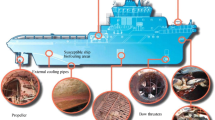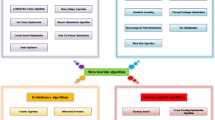Abstract
Due to the unique nature of underwater acoustic communication, data collection from the Underwater Acoustic Sensor Networks (UASNs) is a challenging problem. It has been reported that data collection from the UASNs with the assistance of the autonomous underwater vehicles (AUVs) will be more convenient. The AUV needs to schedule a tour to contact all sensors once, which is a variant of the Traveling Salesman Problem. A hybrid optimization algorithm is proposed for the solution of the problem. The algorithm combines the quantum-behaved particle swarm optimization and improved ant colony optimization algorithms. It is an algorithm with quadratic complexity, which can yield approximate but satisfactory results for the problem. Simulation experiments are carried out to demonstrate the efficiency of the algorithm. Compared to the Self-Organizing Map based (SOM-based) algorithm, it not only plans a shorter tour, but also shortens the distance from the sensor to its closest waypoint. Therefore, the algorithm can reduce the energy required for data transmission since the communication distance drops, and the service life of the sensor can be extended.










Similar content being viewed by others
References
Braca P et al (2016) Distributed information fusion in multistatic sensor networks for underwater surveillance. IEEE Sens J 16(11):4003–4014
Melodia T et al (2005) Underwater acoustic sensor network. Ad Hoc Netw 3(3):257–279
Alzubydi AM, Abdallah MN (2013) Performance assessment of MAC layer protocols in pollution monitoring system based on underwater wireless sensor networks. J Glob Res Comput Sci 4(3):40–45
Stojanovic M, Preisig J (2009) Underwater acoustic communication channels: propagation models and statistical characterization. IEEE Commun Mag 47(1):84–89
Liu R, Yu L (2013) An effective data collection algorithm for wireless sensor network. Computing 95(9):723–738
Lei J et al (2016) An in-network data cleaning approach for wireless sensor networks. Intell Autom Soft Comput 22(4):599–604
Ahmad A et al (2013) AEERP: AUV aided energy efficient routing protocol for underwater acoustic sensor network. In: ACM workshop on performance monitoring & measurement of heterogeneous wireless & wired networks, Barcelona, Spain, pp 53–60, 03–08 November
Chang SH, Shih KP (2015) Tour planning for AUV data gathering in underwater wireless. In: International conference on network-based information systems, Taipei, Taiwan, pp 1–8, 02–05 September
Hollinger GA et al (2011) Autonomous data collection from underwater sensor networks using acoustic communication. In: 2011 IEEE/RSJ international conference on intelligent robots and systems, San Francisco, CA, USA, pp 3564–3570, 25–30 September
Faigl J, Hollinger GA (2018) Autonomous data collection using a self-organizing map. IEEE Trans Neural Netw Learn Syst 29(5):1703–1715
Liu L et al (2010) Prospects and problems of wireless communication for underwater sensor networks. Wirel Commun Mob Comput 8(8):977–994
Hollinger GA et al (2011) Communication protocols for underwater data collection using a robotic sensor network. In: IEEE GLOBECOM workshops, Houston, TX, USA, pp 1308–1313, 5–9 December
Vasilescu I et al (2005) Data collection, storage, and retrieval with an underwater sensor network. In: ACM international conference on embedded networked sensor systems, San Diego, California, USA, pp 154–165, 02–04 November
Yan J et al (2018) Energy-efficient data collection over AUV-assisted underwater acoustic sensor network. IEEE Syst J 12(4):3519–3530
Kebkal V et al (2013) Network coding for underwater acoustic sensor networks. In: 2013 MTS/IEEE OCEANS - Bergen, Bergen, Norway, pp 1–5, 10–14 June
Chen SG et al (2007) Lexicographic maxmin fairness for data collection in wireless sensor networks. IEEE Trans Mob Comput 6(7):762–776
Paley DA et al (2008) Cooperative control for ocean sampling: the glider coordinated control system. IEEE Trans Control Syst Technol 16(4):735–744
Dorigo M et al (1994) Ant colony system: a cooperative learning approach to the traveling salesman problem. IEEE Trans Evolut Comput 1(1):53–66
Mareĉek Jakub (2008) The traveling salesman problem: a computational study. Interfaces 38(4):344–345
Dumitrescu A, Mitchell JSB (2003) Approximation algorithms for TSP with neighborhoods in the plane. J Algorithms 48(1):135–159
Isaacs JT et al (2011) Algorithms for the traveling salesman problem with neighborhoods involving a dubins vehicle. In: IEEE American control conference, San Francisco, CA, USA, pp 1704–1709, 29 June-1
Berg MD et al (2005) TSP with neighborhoods of varying size. J Algorithms 57(1):22–36
Häme L et al (2011) The traveling salesman problem with differential neighborhoods. Oper Res 50(4):950–955
Balas E (1989) The prize collecting traveling salesman problem. Networks 19:621–636
Goemans M, Williamson DP (1995) A general approximation technique for constrained forest problems. SIAM J Comput 24(2):296–317
An HC et al (2012) Improving Christofides’ algorithm for the s–t path TSP. J Acm 62:1–34
Faigl J, Kulich M (2011) An application of the self-organizing map in the non-Euclidean traveling salesman problem. Neurocomputing 74(5):671–679
Shi XH et al (2008) An ant colony optimization method for prize-collecting traveling salesman problem with time windows. In: IEEE international conference on natural computation, Washington, DC, USA, pp 480–484, 18–20 October
Bhadauria D et al (2011) Robotic data mules for collecting data over sparse sensor fields. J Field Robot 28(3):388–404
Hollinger GA et al (2012) Underwater data collection using robotic sensor networks. IEEE J Sel Areas Commun 30(5):899–911
Kennedy J, Eberhart R (1995) Particle swarm optimization. In: Proceedings of IEEE international conference on neural networks, Perth, WA, Australia, Australia, pp 1942–1948, 27 November–01 December
Li B et al (2008) An effective PSO-based hybrid algorithm for multi-objective permutation flow shop scheduling. IEEE Trans Syst Man Cybern Part A 38(4):818–831
Sun J et al. (2004) A global search strategy of quantum-behaved particle swarm optimization. In: 2004 IEEE conference on cybernetics and intelligent system, Singapore, pp 111–116, 1–3 December
Dorigo M et al (1996) Ant system: optimization by a colony of cooperating agents. IEEE Trans Syst Man Cybern Part B 26(1):29–41
Faigl J, Hollinger GA (2014) Self-organizing map for the prize-collecting traveling salesman problem. Adv Intel Syst Comput 295:281–291
Rahman MS, Naznin M (2013) Shortening the tour-length of a mobile data collector in the WSN by the method of linear shortcut. In: APWeb 2013: Lecture notes in computer science, Springer, Berlin, Heidelberg, pp 674–685
Author information
Authors and Affiliations
Corresponding author
Additional information
Publisher's Note
Springer Nature remains neutral with regard to jurisdictional claims in published maps and institutional affiliations.
This work was supported in part by the National Natural Science Foundation of China (U1706224, 51575336, 91748117), the National Key Project of Research and Development Program (2017YFC0306302), and the Natural Science Foundation of Shanghai (19ZR1422600).
Rights and permissions
About this article
Cite this article
Chen, M., Zhu, D. Data collection from underwater acoustic sensor networks based on optimization algorithms. Computing 102, 83–104 (2020). https://doi.org/10.1007/s00607-019-00731-6
Received:
Accepted:
Published:
Issue Date:
DOI: https://doi.org/10.1007/s00607-019-00731-6
Keywords
- Underwater acoustic sensor network (UASN)
- Prize-collecting traveling salesman problem with neighborhood (PC-TSPN)
- Quantum-behaved particle swarm optimization (QPSO)
- Improved ant colony optimization (ACO)




